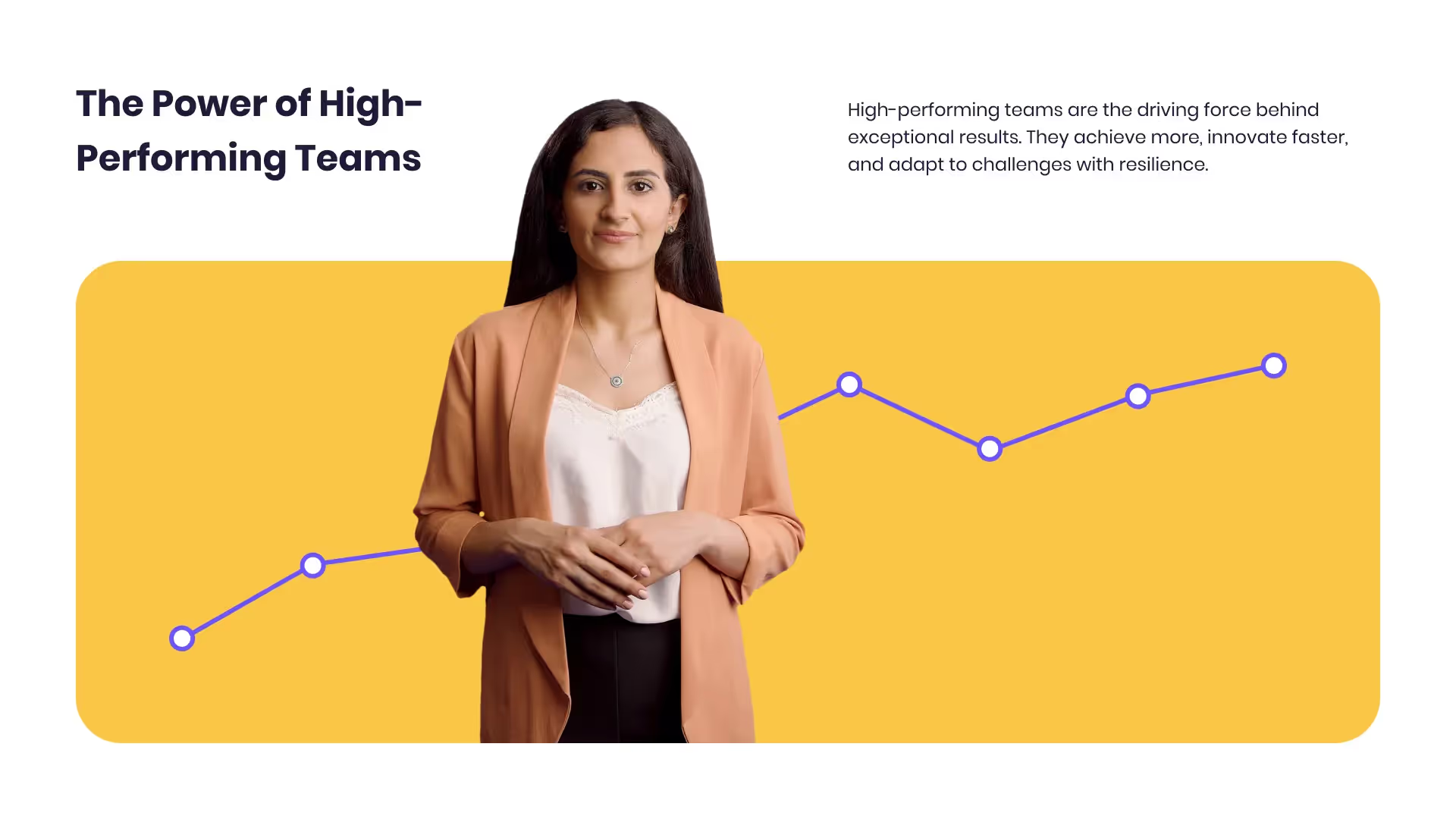Want a personalised avatar?
.avif)
Create an Instant Avatar in under a minute using your phone or camera. Fast, simple, and true to you.

Top 10 Employee Development Training Strategies to Boost Skills in 2025


Employee development is still one of the strongest levers you have for retention, performance, and morale. In LinkedIn’s research, 93% of employees said they would stay longer at a company that invests in their careers, and companies with high internal mobility retain employees for twice as long. A strong learning culture also correlates with 92% more product innovation and 52% higher productivity. Yet 59% of employees report receiving no workplace training. If you want measurable impact in 2025, close that gap with focused strategy and simple execution.
Here are 10 practical strategies I recommend, plus how we at Colossyan can help you implement them without heavy production overhead.
Strategy 1 - build competency-based learning paths
Why it matters:
- 89% of best-in-class organizations define core competencies for every role. Clarity drives better training and fairer evaluation.
What it looks like:
- Map role-level competencies. Align courses, practice, and assessments to those competencies. Review quarterly with managers.
Example you can use:
- A sales org defines competencies for discovery, negotiation, and compliance. Each rep follows a leveled path with skill checks.
How we help at Colossyan:
- We use Doc2Video to turn competency frameworks and SOPs into short, on-brand video modules fast.
- We add interactive quizzes aligned to each competency and export as SCORM with pass marks for LMS tracking.
- Our Analytics show where learners struggle so you can refine the path and close gaps.
Strategy 2 - make internal mobility and career pathways visible
Why it matters:
- Companies with high internal mobility retain employees twice as long. And 93% stay longer when career investment is clear.
What it looks like:
- Publish clear career paths. Show adjacent roles, skills required, and 6–12 month transition steps. Add an internal marketplace of gigs and mentors.
Example you can use:
- “Day-in-the-life” videos for product marketing, solutions engineering, and customer success. Each shows required skills and a learning plan.
How we help at Colossyan:
- We record leaders as Instant Avatars so they can present career paths without repeated filming.
- With Conversation Mode, we simulate informational interviews between employees and hiring managers.
- Brand Kits keep all career content consistent across departments.
Strategy 3 - run a dual-track model: development vs. training
Why it matters:
- Employee development is long-term and growth-focused; training is short-term and task-based. You need both.
What it looks like:
- Split your roadmap: short-term role training (tools, compliance) and long-term development (leadership, cross-functional skills).
Example you can use:
- Quarterly “role excellence” training plus a 12-month development plan toward leadership or specialist tracks.
How we help at Colossyan:
- Templates let us standardize “how-to” and compliance content.
- SCORM exports track completion and scores on the training track.
- For development, we build branching scenarios that require decisions and reflection.
Strategy 4 - scale microlearning for just‑in‑time skills
Why it matters:
- Short modules increase uptake. The University of Illinois offers an “Instant Insights” microlearning series with 5–20 minute modules for flexible learning (source).
What it looks like:
- Build a library of 5–10 minute videos, each targeting one outcome (e.g., “Handle objections with the XYZ framework”).
Example you can use:
- A “Power Skills”-style certification delivered in 3-hour bundles made of 10-minute micro modules.
How we help at Colossyan:
- PPT/PDF Import turns slide decks into short scenes; we add avatars and timed text for quick micro-courses.
- We reuse graphics via the Content Library across a series.
- Analytics highlight drop-off points so we shorten scenes or add interactions.
Strategy 5 - double down on power skills and dialogue training
Why it matters:
- Programs like “Power Skills at Illinois” and “Crucial Conversations for Mastering Dialogue” (14-hour interactive) improve communication, teamwork, and leadership (source). These skills lift performance across roles.
What it looks like:
- Scenario-based role plays for high-stakes conversations: feedback, conflict, stakeholder alignment.
Example you can use:
- A branching scenario where a manager addresses performance concerns. Learners choose responses, see consequences, and retry.
How we help at Colossyan:
- Conversation Mode shows realistic dialogue with multiple avatars.
- Branching flows simulate decisions and outcomes; we track scores for mastery.
- Pronunciations ensure your brand and product names are said correctly.
Strategy 6 - empower self-directed learning with curated academies
Why it matters:
- A survey of 1,000+ US employees found self-directed learning and career development training are the most appealing for reskilling.
- The University of Illinois gives staff free access to 170+ Coursera courses and 1,200+ LinkedIn Learning lessons (source).
What it looks like:
- A role- and goal-based library with suggested paths and electives; learners choose modules and timing.
Example you can use:
- A “Data Fluency Academy” with beginner/intermediate/advanced tracks and capstone demos.
How we help at Colossyan:
- Instant Translation creates language variants while keeping layouts intact.
- Voices and cloned voices personalize narration for different regions or leaders.
- Workspace Management lets admins assign editors and viewers per academy track.
Strategy 7 - close the loop with data, feedback, and iteration
Why it matters:
- Employees are 12x more likely to be engaged when they see action on their feedback.
- Skills gaps can cost a median S&P 500 company roughly $163M annually.
What it looks like:
- Post-course surveys, pulse polls, and rapid updates. Fix the modules where analytics show confusion.
Example you can use:
- After a policy change video, collect questions and publish an updated module addressing the top 5 within 48 hours.
How we help at Colossyan:
- Analytics track plays, watch time, and quiz scores; we export CSV to link learning with performance.
- Commenting enables SME and stakeholder review directly on scenes for faster iteration.
- Doc2Video regenerates updates from revised documents in minutes.
Strategy 8 - use AI to accelerate content creation and updates
Why it matters:
- Marsh McLennan uses digital tools to boost productivity for 20,000+ employees, and AI will increase the need for AI upskilling. Faster production cycles matter.
What it looks like:
- New training in hours, not weeks. Monthly refreshes where tools and policies change.
Example you can use:
- An “AI essentials” onboarding series refreshed monthly as tools evolve.
How we help at Colossyan:
- Prompt2Video builds first drafts from text prompts; we edit with AI to shorten, fix tone, and add pauses.
- Brand Kits apply your identity at scale; Templates maintain visual quality without designers.
- Media features add screen recordings and stock to demonstrate tools clearly.
Strategy 9 - train in the flow of work with digital guidance
Why it matters:
- Digital Adoption Platforms guide users in-app. Training in the workflow reduces errors and speeds proficiency (source).
What it looks like:
- Embedded short videos and step-by-step guides inside the tools people use daily.
Example you can use:
- A CRM rollout supported by 90-second “how-to” clips on the intranet and LMS, plus in-app walkthroughs.
How we help at Colossyan:
- We export MP4s or audio-only for intranet and app embeds; SCORM for LMS tracking with pass/fail criteria.
- Screen Recording captures software steps; we add avatar intros for clarity.
- Transitions and animation markers time highlights to on-screen actions.
Strategy 10 - localize for a global, inclusive workforce
Why it matters:
- Global teams need multilingual, accessible content to ensure equitable development and adoption.
What it looks like:
- Consistent core curricula translated and adapted with local examples, formats, and voices.
Example you can use:
- Safety training in Spanish, French, and German with region-specific regulations.
How we help at Colossyan:
- Instant Translation adapts scripts, on-screen text, and interactions while keeping animation timing.
- Multilingual avatars and Voices localize narration; Pronunciations handle place and product names.
- We export captions (SRT/VTT) for accessibility and compliance.
Measurement framework and KPIs
- Participation and completion rates by role and location (SCORM/LMS + Colossyan Analytics).
- Quiz performance and retry rates aligned to competencies.
- Time to proficiency for new tools; reduction in errors or rework.
- Internal mobility rate; promotions and lateral moves within 12 months.
- Engagement after feedback cycles (pulse survey lift).
- Business outcomes tied to learning culture: productivity, innovation velocity aligned to Deloitte benchmarks on innovation and productivity.
How to set up measurement with Colossyan:
- Set pass marks for interactive modules in SCORM; export and connect to your LMS dashboard.
- Use Analytics to identify high drop-off scenes; adjust microlearning length and interactions.
- Tag videos by competency or program in folders for faster reporting.
Examples you can adapt (from the learnings)
- Career investment and retention: Reference LinkedIn’s 93% and internal mobility doubling retention in a short HR explainer delivered by an Instant Avatar.
- Best-in-class competency clarity: Build a competency library series and include a quiz per competency; cite the 89% best-in-class stat. Export via SCORM.
- Microlearning in practice: Mirror Illinois’ “Instant Insights” with 10-minute modules accessible on any device (source).
- Learning culture ROI: Cite Deloitte’s 92% innovation and 52% productivity plus $163M skills gap cost in a data-focused update for executives.
- Self-directed appeal: Use a choose-your-path branching video and nod to survey data showing self-directed learning is most appealing.
Suggested visuals and video ideas
- 60-second “What competencies look like here” video per role using avatars and on-screen text.
- Branching conversation role-play for crucial conversations with score tracking.
- Microlearning series on core tools using Screen Recording with avatar intros.
- Localized safety or compliance module translated via Instant Translation; export captions for accessibility.
- “Choose your reskilling journey” interactive video that matches learner interests.
Internal linking anchors (for your site architecture)
- Learning analytics
- LMS integrations
- SCORM guides
- Interactive video creation
- Microlearning best practices
- Competency models
- Localization workflows
One final point. Don’t treat development as a perk.
Employees leave when they can’t see progress: 63% cited lack of advancement as a top reason for quitting. Show clear paths.
Build competency clarity. Meet people in the flow of work. And iterate based on data and feedback.
If you do that, the retention and productivity gains will follow.

Networking and Relationship Building
Use this template to produce videos on best practices for relationship building at work.

Developing high-performing teams
Customize this template with your leadership development training content.

Course Overview template
Create clear and engaging course introductions that help learners understand the purpose, structure, and expected outcomes of your training.
Frequently asked questions
What is the difference between employee development and training?

Training targets immediate, task-specific needs. Development focuses on long-term growth via education, certifications, and mentorship. You need both.
How do I encourage employees to engage with development content?

Make career paths visible, offer self-directed choices, and act on feedback. Employees are 12x more engaged when they see action on their feedback.
What content formats work best for 2025?

Short, interactive video modules; scenario-based role plays for power skills; microlearning for just-in-time moments; and localized variants for global teams. AI-assisted production helps you keep pace with change.
How should we measure success?

Track completion, quiz scores, time watched, and skill proficiency. Correlate with internal mobility, productivity, and error reduction. Use SCORM and built-in analytics to iterate quickly.
How do we support AI upskilling?

Launch an “AI essentials” path with monthly refreshes. Combine screen-recorded demos, microlearning bursts, and branching scenarios that cover responsible use and practical workflows. AI demand is rising and will reshape workload patterns.
Didn’t find the answer you were looking for?















%20(1).avif)
.webp)

